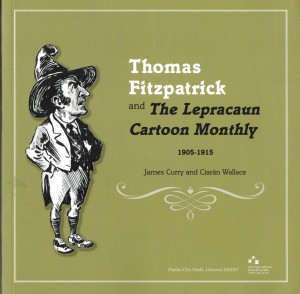Thomas Fitzpatrick and The Lepracaun cartoon monthly, 1905–1915
Published in Book Reviews, Issue 3 (May/June 2015), Reviews, Volume 23JAMES CURRY AND CIARÁN WALLACE
Dublin City Council/Four Courts Press
€19.95
Thomas Fitzpatrick was an artist of the Cultural Revival, although he is seldom cited in that respect. His name is not listed alongside some giants such as Jack B. Yeats, but his graphic skill and his interpretations of an imagined Celtic cultured island mark him out as an exceptional talent. The circulation of his political cartoons for over two decades around the turn of the twentieth century marked him as a powerful satirist and a social commentator with a progressive and abiding empathy for the privations of Dublin’s most neglected citizens.
Fitzpatrick established his imaginative cartoon monthly, The Lepracaun, in May 1905. Before its demise in 1915, it cast a cold eye on Dublin politics and society. He reflected on the Irish political and social order in that unique era styled by Patrick Maume as the ‘long gestation’, from the death of Parnell to the political crisis of 1912, when Fitzpatrick died. The eventual national triumph of the Sinn Féin movement trumped the contemporary priority given to Dublin’s municipal and social world, and with it went awareness of Fitzpatrick’s work.
In his day job, Fitzpatrick produced stylised illuminated addresses and scrolls, drawing on penmanship of the highest order. The wit and humanity displayed in his cartoon work in The Lepracaun gave him the licence to free the inner cynic and humorist genius. As did D.P. Moran before establishing The Leader in 1900, Fitzpatrick worked in London before eventually establishing the cartoon monthly that carved out his reputation.
A biographical essay by James Curry brings together the sparse range of information that is available on Fitzpatrick, showing a courteous, diligent family man, charitable in the extreme, who was deeply upset by the poverty of so many Dubliners. Ciarán Wallace provides a wide-ranging thematic analysis of the images under five headings—society, city politics, national politics, women and labour. His crisp, incisive commentaries on a substantial number of the images show a mastery of Dublin’s history of the period.
Cartoons are snapshots, fleeting images that at their most powerful capture in a moment the swirling pattern of conflict and change that might otherwise demand long, often tedious, exposition. Without the understanding of context, cartoons can suggest a skewed reality. Fitzpatrick showed his acerbic side in a powerful 1909 vitriolic cartoon on Glasnevin cemetery, showing the committee in the guise of a Shylock, a term he also applied to slum landlords. Entitled ‘The Glasnevin Shylock, or the pound of flesh’, the iconic tower features in the background. A thin, hook-nosed, bearded figure clutches a sharp knife engraved with the word ‘fees’, while a poor family grieves over an infant’s plain deal coffin with the inscription ‘died of starvation now called consumption’. Behind the family is a sign, ‘this way to the pit’. In 1909 Glasnevin cemetery altered its purchase grave charges in response to this campaign. Yet the cartoon shows little acknowledgement of the cemetery’s incredible service to the broad cohort of Dublin’s poor, who account for 47% of Glasnevin’s burials in 1905. A family was charged 1s 6d for a ‘poor ground burial’, and institutions paid 5s for the same service.
The volume is copiously illustrated. Wallace calculates that Fitzpatrick contributed over 500 images to the magazine in seven years. Over 150 are reproduced here, alongside the work of other cartoonists. Many readers will be encouraged to check out the original issues. They will find many powerful cartoons not available here that give extraordinary insights into the Dublin of the period. For instance, by 1909 not one insurance company in Ireland was Irish-owned. When the Hibernia Assurance Company (with William Field MP as one of its directors) was established as an Irish insurance enterprise, the scale of Fitzpatrick’s historical awareness was reflected in a cartoon that showed twenty gravestones, each individually carved with the name and dates of a defunct company, all set in a graveyard for Irish insurance companies.
The Lepracaun appealed to the Irish diaspora and is an important contextual source for Dublin of the early twentieth century. Its readers included prominent Irish-Americans such as Joseph McGarrity, and Dublin’s great European, James Joyce. Ulysses celebrates Dublin’s printing artisans and journalists, down even to Bloom experiencing the whirling printing presses in the Freeman building. Jim Fitzpatrick, the modern artist, records in a fascinating foreword that his grandmother told him that Joyce, the ‘notorious scribbler of dirty books’, had done some ‘nixers’ for the magazine. The possibility of a substantiated link to Thomas Fitzpatrick’s great literary contemporary is not developed further in the foreword, or elsewhere in the book. If it could be established that Joyce actually did ‘nixers’ for The Lepracaun, it would further Fitzpatrick’s significance as an artist and as a social commentator.
After Fitzpatrick’s death in 1912, the tone of the journalism and the quality of the cartoons diminish, with Wallace suggesting that its satire had less force. While the book is a suitable tribute to this outstanding magazine, there is work still to be done on the range of Fitzpatrick’s political, commercial and portraiture work between 1881 and 1905, especially his magnificent colourful cartoons that were circulated in weekly supplements of the Weekly Freeman. Curry and Wallace have produced an essential work that will be of substantial value to historians. This book is an excellent tribute to Fitzpatrick, and is an impressive contribution by Dublin City Public Libraries and Archives to the Decade of Commemorations.
Reviewed by
Patrick Callan
Patrick Callan is the former deputy principal of Malahide Community School.

















